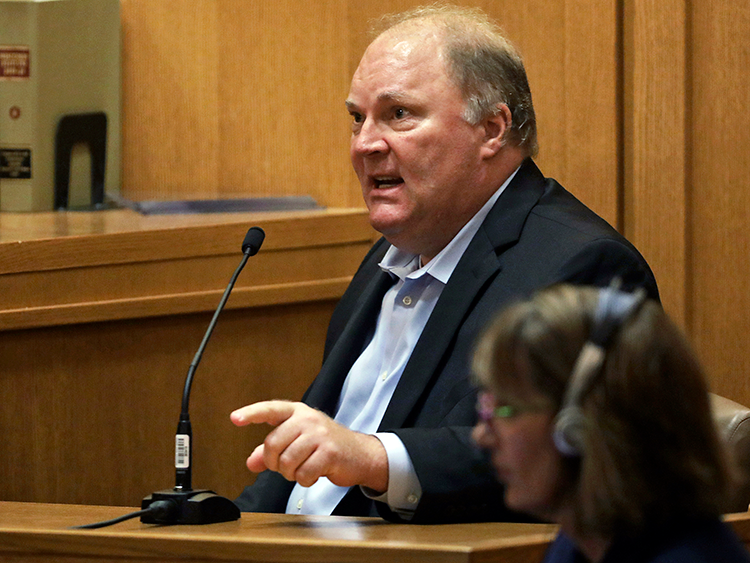Chemerinsky: The stakes are enormous for immigrants in upcoming DACA cases

Erwin Chemerinsky. Photo by Jim Block.
On Nov. 12, the U.S. Supreme Court will hear oral arguments in a trio of cases involving whether President Donald Trump acted impermissibly in rescinding the Deferred Action for Childhood Arrivals program. The cases—Department of Homeland Security v. Regents of the University of California, McAleenan v. Vidal (previously Batalla Vidal v. Nielsen) and Trump v. NAACP—likely will determine the fate and future of about 800,000 “Dreamers,” young men and women who were brought to the United States at an early age.
The DACA program and its repeal
President Barack Obama announced the DACA program in 2012. To be eligible, an individual must have been brought to the United States before age 16 and be younger than 31. The person must be in school or have graduated high school, or be in the military or have been honorably discharged. The individual must not have a conviction for a felony or a serious misdemeanor.
Pursuant to federal immigration law, these individuals are given deferred deportation status for a period of two years, which can be renewed. This means that they do not have to fear being deported during this time and are eligible for work permits. There are many Dreamers in my law school and on my campus. I should disclose that I am co-counsel for the plaintiffs in one of the cases before the court.
After hesitation, Trump chose to repeal this program in 2017. Rescinding DACA is part of Trump’s strong anti-immigrant policies. His justification for repealing DACA is his view that it was illegal for Obama to create it.
Three federal district courts issued preliminary injunctions against the recission of DACA, and one of these was affirmed by the U.S. courts of appeals. The Supreme Court granted review in the other two cases before they were reviewed by their respective courts of appeals. All the courts to rule held that DACA was lawful, and there was therefore no legitimate reason for repealing it.
The Arguments Before the Court
The Trump administration and its amici argue that DACA was an unconstitutional exercise of presidential power, and that doubts about its legality justified its repeal. In United States v. Texas, a federal district court declared unconstitutional a similar Obama executive order: Deferred Action for Parents of Americans. This program granted deferred deportation status to undocumented individuals in the United States who are parents of children who are U.S. citizens.
The 5th U.S. Circuit Court of Appeals at New Orleans affirmed and held it unconstitutional in a 2-1 decision. In June 2016, the Supreme Court split 4-4 and affirmed the 5th Circuit by an evenly divided court. The Trump administration chose to rescind DACA and pointed to the decision invalidating DAPA and also a federal district court decision striking down DACA.
Ultimately, the Trump administration is arguing to the Supreme Court that Trump has broad discretion in matters of immigration. Most recently, in Trump v. Hawaii in 2018, the high court upheld Trump’s ban on immigration from designated countries and reaffirmed expansive presidential powers over immigration. Trump contends that he lawfully exercised this authority to end DACA.
On the other side, the plaintiffs argue that a federal administrative action must be justified by an articulated legitimate reason. Otherwise, it is arbitrary and unreasonable in violation of the federal Administrative Procedures Act. In June, in Department of Commerce v. New York, the court invalidated the Trump administration’s adding a question about citizenship to the 2020 census forms. The court, in an opinion by Chief Justice John G. Roberts Jr., said the Commerce Department failed to articulate a reasonable ground for doing so.
The plaintiffs contend that DACA is legal as an exercise of presidential prosecutorial discretion. It is estimated that there are about 11 million undocumented individuals in the United States. At most, the government deports about 400,000 per year. DACA was Obama announcing the government’s priorities in immigration enforcement.
Some presidential history
Presidents of both parties have exercised discretion with regard to immigration. In 1987, the Reagan administration took executive action to limit deportations for 200,000 Nicaraguan exiles, even those who had been turned down for asylum. Similarly in 1990, President George H.W. Bush limited the deportations of Chinese students, and in 1991, he kept hundreds of Kuwait citizens from being deported.
President Bill Clinton regularly used his power of prosecutorial discretion to limit deportations. In 1993, he gave 18-month extensions to Salvadoran residents; in 1997, he limited deportations for Haitians; and in 1998, he limited deportations to Central American countries that had been devastated by hurricanes.
President George W. Bush also took major steps to limit deportations on humanitarian grounds. In 2001, Bush limited the deportation of Salvadorian citizens at the request of the president of Salvador, who said their remittances were an important part of their nation’s economy.
The Bush administration embraced prosecutorial discretion, and it ordered the consideration of such factors like whether a mother was nursing a child or whether an undocumented person was an American military veteran in making the determination on whether to order a deportation.
What’s at stake
The stakes are enormous. Most importantly, the case will determine whether about 800,000 people have to fear deportation. Often, this would be to countries where they lived for only a brief time. Even if they’re not deported and whether DACA is repealed, they will lose work permits and other benefits that come with DACA status.
The case also will be important for administrative law and how the court will treat the requirement for a legitimate reason for an agency action. And underlying it all is the scope of Trump’s powers with regard to immigration.



